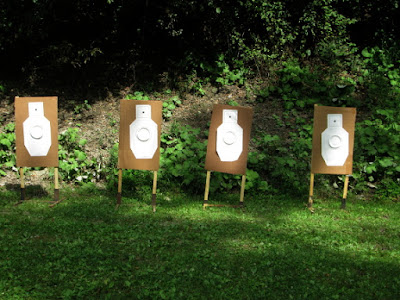The nice thing about rifle night, at least from the activity
director (big title for the guy who sets it up), is you do things you’re
interested in. Sometimes it doesn’t have
to involve rifles.
At our last rifle night we started by timing in with our
pistols at about 5 yards. Of the six
participants, only a few could draw an unconcealed weapon and hit the target
center of mass with one round under 2 seconds.
We cycled through the drill a few times and most of us got it under 2 seconds.
 |
| We use paper plates as replaceable centers, |
We backed up another 5 yards for a total of 10 yards, slung
our ARs and repeated the drill. While we
fired three rounds, I was only interested in the time to first round. To my surprise, despite holding the weapon in
the low ready it took most people almost the same time to bring the rifle up
and fire as drawing the sidearm and fireing.
I had them back-up as I thought it would be too easy at 5
yards, just point and pull.
I made a few observations on timing in:
Several people, drew their pistol and then repositioned
their bodies or moved their feet. This
always took extra time. Learn to shoot
with your feet where they are.
Some had trouble with their operating controls. That includes safeties and sights. One shooter using a dot sight on his pistol
showed improved time simply by switching to iron sights. He is still in the learning curve of finding
the reflex sight’s dot. A dot sight
could be the answer to several age related problems. There are several ways to shoot a dot sight,
including using the entire sight as a giant ghost ring.
Many of us shoot several guns. Why?
Because we can, but we don’t get the benefit of shooting the same gun
over and over again. Speaking for myself,
I suspect we’re having trouble with our sights.
This can be cause by several factors.
We may not be able to see them sharply.
We aren’t bringing up the gun with the front sight visible in the rear,
or we’re trying to get the front sight level, even and perfectly symmetrical in
the rear sight. A perfect sight picture
will never happen outside of a ransom rest.
Dry firing and practice drawing will help that with all of
these.
One of the best local shooters has natural talent. He really shoots better than any of the other
local shooters. He doesn’t practice,
he’s that good. Watching him you realize
he makes no unnecessary motion. His draw
doesn’t look that fast, but his time is.
Again, it’s because he doesn’t waste time with unnecessary motion. I suspect he has a well developed sense of
proprioception, but in any case reducing unnecessary motion will improve your
time.
I expected rifle time to be faster since the gun was already
out and in your hands, so I was a little surprised it took about the same time. I suspect since the rifle was heavier than a
pistol, with different balance and requires two hands so it took longer to mount
the rifle and crack off a round. The
rifle bridges hands, shoulder, eye and target so it may actually be more
complicated than shooting a handgun.
Here too, practice would improve performance.
We also ran a reverse Tueller drill. What’s a Tueller Drill? The short answer is it demonstrates how fast
a person can close on you while you are drawing your sidearm. You can read more at:
This time we placed the ‘armed’ humanoid target at 21 feet
and attacked them with a target on a mover.
It’s a simple system, you pull a rope as fast as you can, the shooter
tries to get at least one round off before they are run over by the oncoming
target. By placing the puller behind the
shooter, the movement is surprise.
 |
| An easy to make mover, the wheels are the most expensive part |
The rules were simple.
When the mover starts, you react.
Even with piece of paper on a wood frame, many shooters found it
intimidating. Most of us instinctively
moved sideways from the moving target.
We discovered most of us were point shooting as the target
was on top of us by the time we fired. Weapon
retention was called for, not sight picture.
Even practicing it several times didn’t drastically change
the outcome.
Because of the layout of the tracks of the mover, all the
shooters moved to their left so any misses and shoot throughs hit the ground to
the shooters right. Not only do you need
to look at what’s the backstop behind the shooter, but to the left and right.
We repeated the experiment with the rifles. We moved the
shooters back to about 36 feet and discovered the same thing. It takes longer for a person with a rifle to raise
the rifle from the low ready and discharge one round. Assuming that at least one of the 8 or 9
people shooting was a competent rifleman, this is astonishing.
The drill indicates you can run over 10 yards ( a football first
down!) and stab a rifle man before he can get his rifle up and discharge one
round. That’s true for 7 yards with a
pistol in a holster. This implies you
need more reactive gap with a rifle than a pistol!
Comments
Post a Comment